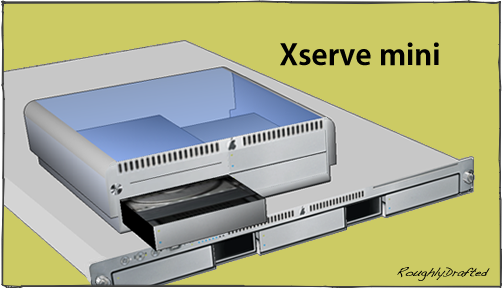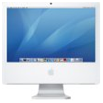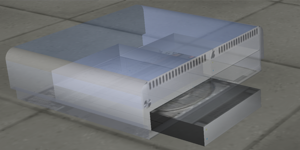


 Two and a half years ago, I wrote an article presenting how Apple should move their Flat Panel iMac into the future: plop three inches of Mac on the back of a Cinema Display and call it the new iMac. I also presented why the alternatives made no sense. As it turned out, I was spot on.
Two and a half years ago, I wrote an article presenting how Apple should move their Flat Panel iMac into the future: plop three inches of Mac on the back of a Cinema Display and call it the new iMac. I also presented why the alternatives made no sense. As it turned out, I was spot on.  Apple did exactly what I predicted: they dumped the igloo iMac and released a computer integrated into a slightly thicker version of their display as its successor. Since Ive, Jobs and company are all no doubt anxiously awaiting my next new idea for a new Mac product category, I’ll get right into presenting what it is, and why the world needs (drumroll please)... the Xserve mini.
Apple did exactly what I predicted: they dumped the igloo iMac and released a computer integrated into a slightly thicker version of their display as its successor. Since Ive, Jobs and company are all no doubt anxiously awaiting my next new idea for a new Mac product category, I’ll get right into presenting what it is, and why the world needs (drumroll please)... the Xserve mini.Apple’s Xserve
Shortly after I published that iMac article in the spring of 2002, Apple released their first version of the Xserve. Prior to that, Apple had been selling server versions of their G3 and G4 PowerMacs, but there wasn’t really anything special about the hardware; they were just regular Macs running Mac OS X Server.
The Xserve was completely redesigned to look, act, and run like a server. It came in an industry standard 1U case designed to be mounted in a server room telco rack or cabinet, and featured hot swap drive bays for Apple Drive Modules. Unlike previous Apple hardware, the Xserve was also equipped with a standard PC serial port for console management. Somewhat ironically, there are no other Macs with a serial port, so connecting to the console requires a PC.
The original Xserve was frighteningly loud, and its thin, flat, and very long case made it a complete oddity for many Mac oriented business users who weren’t large enough to need their own data center room. While they were trying to figure out where to put their Xserves, one of the largest and most famous deployments of Mac servers, the Virginia Tech supercomputer, was built using full size PowerMac G5s, because the Xserve G5 wasn’t available yet.
The Xserve Market
Virginia Tech has since migrated to using Xserves, and the Xserve has found additional healthy interest in high performance computing due to its fast and cool processor and its densely packed form factor.
Apple paired the Xserve with the matching, rack-mounted Xserve RAID, which can either act as two independent RAID devices for directly attached systems, or serve multiple network hosts in a shared configuration acting as a SAN.
Apple’s Xsan product allows client machines to directly access an Xserve RAID over a fast Fibre Channel network as if it were a local SCSI drive, and enjoy the performance of direct, exclusive access to the unit. This is different than a typical file server or NAS, where users share access to the same set of files. Using a SAN, there is no file server acting as a bottleneck, and no contention, file locks, or other sharing issues to worry about.
 Apple’s Xserve, Xserve RAID, and Xsan are Enterprise level products, with a price to match. Unlike Apple’s Mac desktops, which are often viewed as premium machines when compared to PCs, Apple’s Xserve lineup is generally considered a low cost alternative to other high end server, RAID, and SAN products.
Apple’s Xserve, Xserve RAID, and Xsan are Enterprise level products, with a price to match. Unlike Apple’s Mac desktops, which are often viewed as premium machines when compared to PCs, Apple’s Xserve lineup is generally considered a low cost alternative to other high end server, RAID, and SAN products. Apple’s hardware is not only competitively priced, but offers software licensing that is far lower than competing Enterprise alternatives. For example, Apple introduced their own HBA (Fiber Channel interface card) for $500 in a market that commonly sells the same product for $1500; Xsan software costs $1000 per server; alternatives are in the $3000-5000 range, and typically also require $3500 balancing software that Apple includes with Xsan.
Introducing the Xserve mini





While Apple might be offering low cost alternatives to Enterprise users, Xserve pricing is out of the league of most small businesses, and certainly not in the ballpark for home users.
The Xserve mini is a new product category that borrows from the Xserve to deliver features for home and small business users.
Why would home users need a server? I’ve written before about emerging applications for servers within Apple’s core Mac market, and I’ve added more below.
Actually, Apple has already delivered a number of server software solutions that would be highly valuable to both home users and small to medium sized business. All Apple needs to do is make some of these features more accessible and advertise them.
 Mac OS X Server can already run on any Mac; until last year, I was running it on the salvaged remains of a 400 MHz PowerBook, which had lost its display in my 2004 motorcycle accident. After a simple install, Mac OS X Server can be set up with point and click simplicity to run a variety of services, but even the 10 client limited version costs $500.
Mac OS X Server can already run on any Mac; until last year, I was running it on the salvaged remains of a 400 MHz PowerBook, which had lost its display in my 2004 motorcycle accident. After a simple install, Mac OS X Server can be set up with point and click simplicity to run a variety of services, but even the 10 client limited version costs $500.How to make a mini
In order to create a low cost server product targeted to users who need a server but don’t have a full time IT department, Apple needs to deliver a simple, compact hardware unit with some of the Xserve’s features, and less of its complexity. It would include a streamlined version of Mac OS X Server suited for the Xserve mini’s applications.
 To illustrate the idea, I drew up a quick rendering of a desktop sized unit with three drive expansion bays for use with the Xserve’s standard Apple Drive Modules. The renderings were modeled using Google’s free SketchUp. You can download my Xserve mini model.
To illustrate the idea, I drew up a quick rendering of a desktop sized unit with three drive expansion bays for use with the Xserve’s standard Apple Drive Modules. The renderings were modeled using Google’s free SketchUp. You can download my Xserve mini model.


The three drive bays would provide the flexibility for significant expansion; using Apple’s latest 500 GB drives, enough capacity for hard disk based backup, rather than using slow and cumbersome tape devices.
Using ADMs would allow for RAID and other choices:
-
•high performance disk striping;
-
•the data protection of a disk mirror;
-
•a hot spare drive;
-
•removable drives for offsite storage and archive.
Apple’s Currently Lacking Lineup
Apple currently doesn’t produce anything to fill the home or small business server space. The standard Xserve is too big, and the Mac mini is too small: it uses a portable laptop hard drive, which is neither fast enough for a server, nor designed to withstand constant, heavy duty use.
 Full size PowerMacs only hold two SATA hard drives, limiting potential expansion. Additionally, the PowerMac is designed as a user workstation, with a fancy graphics card, digital sound ports, and a sophisticated fan system to render it mostly silent. Those features make the PowerMac larger and more expensive than a server needs to be.
Full size PowerMacs only hold two SATA hard drives, limiting potential expansion. Additionally, the PowerMac is designed as a user workstation, with a fancy graphics card, digital sound ports, and a sophisticated fan system to render it mostly silent. Those features make the PowerMac larger and more expensive than a server needs to be. The Xserve mini would only need an Ethernet port, USB ports, and a PCI Express expansion card slot. It would be remotely configured over the network like a glorified Airport base station unit.





Apple’s Server Admin Tools are already designed to set up a Xserve from scratch across the network. By adding some very basic simplifications, the Xserve mini could provide entirely headless operation: no monitor, keyboard, or mouse, just a power cord and a network cable. Businesses could plop it a closet, and home users could leave it on the living room shelf.
Xserve mini Applications
So why would home and small business users need a small, dedicated appliance server? Here is a quick overview of the services the Xserve mini would provide, and why Apple can add value over existing appliances.
1 - Remote Access Services
Like an Airport base station, it would allow users to dial in over the phone using regular dialup networking to access their files. The server would use an optional USB modem.
Increasingly, mobile users now have access to high speed Internet. So the XServe mini would also provide VPN services, allowing users to authenticate over the Internet and securely connect to their files fast from anywhere.
Apple already provides these two products, but not in one appliance server. Apple can also deliver a very simple dialup and VPN experience by having the Xserve mini generate the automatic configuration files used by Internet Connect. Users just double click on a setup file, and are ready to connect remotely.
2 - Media Storage Vault
In addition to printer sharing, AppleShare file sharing for Macs, and SMB file sharing for Linux and Windows PCs, the Xserve mini could act as a large, central iPhoto archive and iTunes media server. These would be automatically found by clients using Bonjour.

Mac OS X Server already ships with simple file and print services, and it would be easy to include a version of iLife that serves as a central vault for a home or office’s photos and music. Of course, iLife already knows how to find shared media folders. Apple needs to add similar simplicity to discovering file shares in the Finder. It is still somewhat clunky and inconsistent to use Connect to Server or to browse for servers under the Network icon.
Once a variety of important data is all kept in one place, it makes it much easier to back it all up. RAID would provide some protection from hard drive failure, and the ADM removable drive trays would make it easy to backup a live system image to keep in a safe location. The system could also backup incremental changes to DVD-R.
In addition to sharing files with iLife clients, the Xserve mini could also act like a home media server, using QuickTime Streaming Server for direct audio and video playback on remote devices over the network: AirTunes playback to any speakers, multicast video streaming to a number of PCs at the same time, or Internet streaming to remote locations, such as a secondary office or as part of a video telecast or teleconferencing session.
Any device with a network connection could be used to play back content from the server: ripped library content, downloaded movies including MPEG, DIVX, DVR files, or content streamed live from the web, such as YouTube, Google Video, QuickTime trailers, and other streamed video feeds. The server could even easily time shift streamed content for later playback.
Along those same lines, the Xserve mini could also be set up to cache all outbound requests for data, speeding downloads of frequently visited websites and software updates for multiple computers. It could also serve as a firewall and email spam filter gateway.
An information ripping server aggregates information to go, searching for selected content online and converting it into audio or video clips or to Notes format for use on an iPod or other device.
It would also handle centralized media scaling services, to convert DVDs and online content into formats optimized for use on a laptop, iPod, mobile phone, or other mobile device. This would obviously benefit from integration with a centralized media storage vault.
6 - Directory Services
Using Portable Home Directories, users with a laptop can connect to the network and sync all their documents, then log into a desktop Mac and continue working on the same files. That also enables business users to sit at any Mac and have all their desktop files and settings. It also works with PCs, and is similar to Windows’ Roaming Profile feature.
Directory services also allows central management of file permissions, sharing, and VPN access. Users only need one account to get everything they need to do their job. It’s necessary for businesses, but it’s actually really handy to have at home, too. The Xserve mini could bring Apple’s server technologies to home users who simply don’t know what they’re missing.
7 - Local .Mac Services
I wrote a series of articles looking at how and why Apple could add real value to their .Mac services. Prior to that, I wrote about how they could deliver a personalized version of the WebObjects applications that drive .Mac. Along those lines, Apple could deliver much of the value in .Mac for businesses to run themselves.
For example, Apple could enable .Mac to use a company’s local servers to provide syncing for their users’ Safari bookmarks, Address Book contacts, and iCal calendars, as well as .Mac style webmail. That would provide a strong alternative to Microsoft’s Exchange Server for small businesses at a much lower cost, particularly when comparing the client access licenses Microsoft requires for every user.
 Apple could also deliver their Backup software to schedule client machine backups to the local server. Backing up to .Mac might work for casual home users, but for businesses users with lots of data, a local Xserve mini makes far more sense.
Apple could also deliver their Backup software to schedule client machine backups to the local server. Backing up to .Mac might work for casual home users, but for businesses users with lots of data, a local Xserve mini makes far more sense.As mentioned earlier under directory services, the Xserve mini could also sync an entire user’s directory folders: desktop, documents, movies, and music. That’s something that isn’t practical with .Mac, especially given Apple’s limited storage and the fairly slow upload throttle on their servers. Beyond that, they could also deliver my idea for a version controlled, personal server archive.
Professional home and small business users would also benefit from an automated application of Apple’s Software Restore technology and incremental backups that would enable them to flashback to a previous system when things go wrong, or to new Mac in the case of an unexpected hardware failure.
Apple could also sell the Xserve mini as a low end distributed processing box. Using Apple’s Xgrid software, users could dump rendering tasks on the Xserve mini, or benefit from behind the scenes, intelligent distributed multitasking.
Just as CoreVideo offloads video processing to the graphics card, Xgrid sends chunks of data needing processing to network clients available for background number crunching. Easy support for creating distributed tasks, if integrated into Leopard’s core client APIs, could be used to speed long Photoshop imaging tasks, intensive video rendering, large print rasterizing tasks, and anything else imagined by brilliant third party developers.
9 - NetBoot
Internet cafes, training stations, kiosk operators, schools, and retail stores could all benefit from an automated NetBoot appliance server. Anyone who needs to flash over several Macs with a clean install on regular basis, just as Apple does in their own retail stores, could easily configure their Xserve mini to handle that on the side.
Saving the best for last
I saved the real killer application for the Xserve mini for another article. Stay tuned to find out what it is! You can also contribute your own ideas for a home and small business server unit and I’ll make note of the best ideas in the followup story.
Next Article:
This Series
Put RoughlyDrafted Magazine on your Dashboard and be the first to see the latest articles! I appreciate blog links, social networking postings such as deli.cio.us, and reddit.com, and readers who share articles via emails or newsgroups. Thanks!

| | Comment Preview
 Read more about:
Read more about:

 Send |
Send |

 Subscribe |
Subscribe |
 Del.icio.us |
Del.icio.us |
 Digg |
Digg |
 Furl |
Furl |
 Reddit |
Reddit |
 Technorati
Technorati
Click one of the links above to display related articles on this page.
The Xserve mini
Monday, July 24, 2006





















